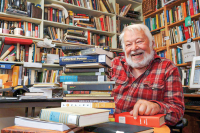A natural fit: Balsam nature center a hub for research and education in the mountains
 “Hey buddy, you about ready to come out?” Michael Skinner asks the juvenile broadwing hawk standing in the back of a plastic carrying case.
“Hey buddy, you about ready to come out?” Michael Skinner asks the juvenile broadwing hawk standing in the back of a plastic carrying case.
Skinner, executive director of the Balsam Mountain Trust and jack of all environmental trades, slowly reaches his gloved hands inside and pulls the raptor out. The bird flaps its brown-and-white wings for a moment but quickly settles down. Skinner sets him atop the cage for a moment, where he sits untethered, surveying the small storage room where Skinner keeps supplies for the nature center’s diverse charges — everything from box turtles to an opossum to a bald eagle.
The hawk came in with Brock Auvil, a sergeant with the N.C. Wildlife Resources Commission. A trucker driving in Cherokee County near Andrews had found the little guy on the side of the road and notified the Wildlife Commission. Auvil, in turn, brought him to Skinner.
“It really helps to have a midway point with you guys,” Auvil told Skinner. Otherwise, he’d have to bring the hawk all the way to the Western North Carolina Nature Center in Asheville — quite a trek from Andrews. Balsam is a waypoint for the hawk to get examined and hooked up with any emergency treatment it needs.
The bird will head to the WNC Nature Center eventually, however.
“We are not wildlife rehabilitators,” Skinner said. “We’re wildlife educators.” Legally, he can keep birds for only 72 hours before getting them to a vet or rehabilitator.
Related Items
The nature center, which is under the nonprofit Balsam Mountain Trust, has quite a collection of native animals — eight raptors, a variety of reptiles, an opossum — but they’re all healthy specimens that Skinner uses for educational purposes.
Skinner looks the broadwing over carefully, holding him firmly, feeling his muscles and inspecting him for injuries.
The prognosis is positive. He doesn’t seem to be sick or injured, and aside from a somewhat lacking fear response to humans and slightly weak chest muscles, everything looks good.
“I see no reason why this bird can’t have a successful wild life,” Skinner says.
Watch Skinner inspect a bird, and it’s clear he knows what he’s doing. But dealing with troubled birds is far from being his — or the nature center’s — only responsibility.
Planning to stick around
The nature center operates under the nonprofit Balsam Mountain Trust, an organization focused on improving stewardship of the area’s natural and cultural resources through research and education. The nonprofit gets its money mainly from private donations, grants and a mandatory donation tacked onto each real estate sale in the development, equivalent to 1 percent of the price.
“Our mission is kind of a three-legged stool, which is conservation, education and research, and those things all play off each other,” Skinner said of the Balsam Mountain Trust.
The future of the nature center in its current home is uncertain, however. A capital investment lender from New York has foreclosed on the nature center. The lender previously foreclosed on the entire development when its owners couldn’t pay back the money they’d borrowed. At the time, the nature center was exempt from the foreclosure and carved out of the larger development, but now the lender is trying to close out the books. That means coming back to foreclose on the nature center.
But Skinner, who has held the director’s position since 2002, two years after the trust began, said he doesn’t see himself being out of a job anytime soon.
Homeowners at the Preserve are hoping to work out a deal with the lender to keep the nature center building. The trust is developing a backup plan for relocating the nature center, should it lose the property (see related article on page 14).
“As far as I’m concerned and as far as my board’s concerned, we’re not going anywhere,” Skinner said.
For Skinner, that’s a relief, because he loves his job about as much as possible. He’s got a hand in all three legs of the nature center’s mission — conservation, education and research — and counts himself lucky have the opportunity.
“When I go out into the woods, it is just so humbling to find out so quickly how much I don’t know, which is also what keeps it fun,” he said.
The three-legged stool
The nature center, located on the private preserve, plays host to researchers with organizations ranging from tiny colleges to the Smithsonian Institution. Since its inception, the nature center has hosted nearly 40 different research studies. The fact that it’s on private land makes it an attractive place for researchers to study, Skinner said, guaranteeing the public won’t stumble across study areas researchers would rather be left alone.
“It makes it really nice for researchers who want to test research plots here,” he said. “They don’t get messed with.”
The nature center also has its own in-house projects aimed at conserving and protecting the preserve’s many natural assets.
A milkweed breeding project spearheaded by the nature center’s AmeriCorps volunteer Becka Walling is helping to find local milkweed populations and get them planted more widely on the preserve. Milkweed is the sole food source for the caterpillars of monarch butterflies — a beautiful but declining North American species — and itself decreasing in numbers. The hope is that planting more milkweed will lead to increased monarch populations.
But conservation makes its mark in a much bigger way, as well. The property at Balsam Mountain Preserve includes a 3,500-acre conservation easement with Pennsylvania-based North American Land Trust. The Balsam Mountain Trust, NALT and the Preserve’s land management team manage the easement to increase forest health, species diversity and recreational benefit.
Skinner and the rest of the center’s personnel — education coordinator Rose Wall, Walling and a “stable of volunteers” — make it outside the preserve quite frequently, as well.
Skinner’s pretty well-known for his wildlife education programs, especially the birds of prey program, which makes appearances everywhere from local schools to the Great Smoky Mountains National Park. Through its Adopt-A-School program, the nature center tries to take its animals to places that can’t afford the fee, with six schools so far sponsored by various area businesses to receive programming.
“I’ve heard so many people say there’s just so many nature shows on and people know so many things about nature. I find that is so not accurate,” Skinner said. “We’ve got well over 1 million acres of land in Western North Carolina and people live all around it, but they know very little about it.”
Expanding ‘common knowledge’
Skinner’s all about bringing up the level of common knowledge. He enjoys looking for answers to questions he hasn’t been asked before, but he’s also able to come up with quite a bit of information on his own, proficient in everything from local ecology to identifying plants and animals.
Case in point: a brief encounter on the steps outside the nature center turned into a long conversation when a couple visiting the building started asking about the identity of a snake they’d recently seen. It didn’t look like a garter or black snake, they said, and they wondered if maybe it was a venomous species. Its head looked kind of triangular.
To which Skinner embarked on an explanation that garter snakes in this area have some of the most varied patterns of any garter population, making them harder to identify. And it’s a mistake to say that snakes with triangular heads are venomous, because many snakes — even non-venomous ones — flatten their heads when threatened, giving them a triangular look. Knowing the area where they’d spotted it, he said, he’d bet money it was a garter snake.
The nature center also holds on-site education programs that are good bit more organized than chance encounters on the porch.
With permission, hiking clubs and groups can explore the preserve’s trails, and field trips to experience everything from streams to waterfalls to forest ecosystems take place there. In Skinner’s view, the preserve’s status as private land makes those adventures especially worthwhile.
“We don’t have to be in any hurry,” he said. “We can bring people to the research projects that are going on, explain that to them. I think that is a huge benefit that we are not public land. I think it becomes a little more intimate. You get to really delve into things and explain things.”
For Skinner, that’s important. It’s why he’s stayed at the nature center for as long as he has, and it’s why he believes in the nonprofit’s value to the area.
“Answers beget questions, which is the way it should be,” he said. “If you have a curious bone in your body, you’re going to be well-served your entire life if you study this stuff.”









